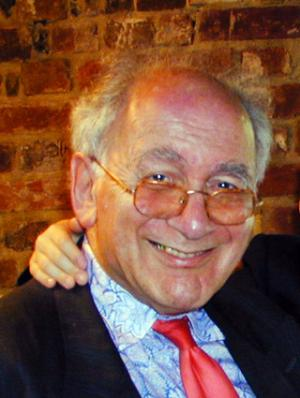Catholic Medical Quarterly Volume 61(3) August 2011, 45-6
Obituary
Dr Seymour Spencer KSG. A great master.
By Dr Peter Doherty.
 Seymour
Spencer died in May this year at the age of 91. A former Master of the
Guild he left a legacy that we can all be grateful for.
Seymour
Spencer died in May this year at the age of 91. A former Master of the
Guild he left a legacy that we can all be grateful for.
Elderly members of Council who served with Seymour both as Master and member will remember at those dreary starts to the meetings when apologies for absence have been agreed and 'minutes of the last meeting' had arrived there was an inevitable pause. Seymour, with a mischievous grin, could always find spelling mistakes, missing colons , full stops or commas in the wrong places, or an over-hastiness by the unfortunate reporting secretary. It probably followed from his schooling at Winchester, renowned for its perfectionist teaching of English.
Seymour was born Seymour Schlesinger to prosperous Jewish parents. His mother Dorrit was the daughter of Henry van den Berg, whose family company originated in Hamburg and produced Stork margarine. After merging with Lever Brothers they formed the basis of the conglomerate Unilever. On his father's side his grandfather was a merchant banker and chairman of Keyser’s Bank in the City of London. His father served in the first war and subsequently joined the Bank.
Seymour won a scholarship to Winchester and went up to Oxford in 1938 to read medicine, which as his son said was inevitable as he could never imagine Seymour wanting to kill anyone even in wartime. While at Oxford, war broke out. He changed his name to Spencer, understandable under the circumstances. After qualification in 1943 he met an Ampleforth monk, Fr. Aelred of St. Benet's Hall who introduced him to Fr. Conrad Pepler of Blackfriars and after instruction he converted to Catholicism. This created anxiety among the Jewish community as he was known as a profound Talmudic scholar, and a Rabbi was sent from London when his intentions became known. However, his mind was made up and there began a lifetime’s association with Ampleforth. While working in House Appointments in Newcastle, he met and fell in love with a beautiful young nurse, Margaret Behn, and they married in October 1944. By then he was in the RAMC and shortly afterwards was posted to India.
After demobilisation in 1947 he took up post graduate training in psychiatry and became a consultant at the Warneford Hospital in Oxford in which he remained for the rest of his life. As a consultant psychiatrist his interests were always with people. But he also undertook forensic work giving evidence in numerous legal cases, including murder cases. Whatever the person had done he never regarded him as irredeemable and believed there would be some explanation and dug and dug until he found it, exploiting it to the full. He gave his psychiatric services to the Church. He helped monks who developed mental health disorders as well as priests of the Archdiocese of Birmingham, particularly at Our Lady of Victory, Brownshill, a centre for psychiatrically ill priests. For this work, he was made a Knight of St. Gregory.
My sister-in-law lived at the top of Brownshill which is the south side of the Chalford Valley, which leads into Stroud. The approach to the top was steep and twisty, but Seymour in his ageing Ford Saloon always accomplished the ascent at a very generous speed. The Rector used to tell me how relieved he was to greet him on arrival as there had been many altercations on the route before with brick walls. But Seymour did see risks where others did not. In one case of sexual abuse, Seymour warned that, based on his assessment, resolution was unlikely. Other psychiatrists did not recognise this and, sadly, at a time when, perhaps, the medical profession and others dealt with such things more leniently, Seymour’s was the minority opinion. He also used to go nuclear when the current practice of jailing severely psychiatric patients in prisons was debated.
My relations with him stretched from my appointment as Editor of the CMQ. He was made Chairman of the Board. We built up an astonishing camaraderie and enjoyed so many of the issues on which we both approved. My contribution of 'Tadpole' stimulated him to present 'Old Frog', which we hoped provided some relief from the high issues we were debating. His wicked sense of humour always prevailed. Many found it distasteful. Martin, one of his sons, recalls that the day before he died he complained of blurred vision whilst his daughter was with him in the morning, but had cleared up by the time Paul, another son, visited him in the afternoon. When Paul asked him, “Dad, can you see me clearly?” he replied, “Yes, unfortunately”.
He has now joined Margaret, which has been his wish since her death. They are now united and we have lost a wonderful eccentric who delighted in irritating people whom he greatly admired and manifested his regard for them by doing so.
